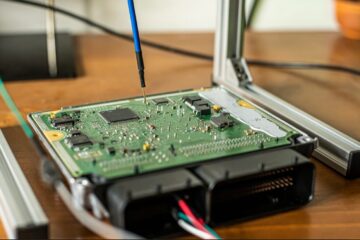Did you know that a car’s average lifespan is around 12 years (or 200k miles)? The cars that we have today last longer than older models that gave only 15k miles throughout their lifespan.
However, studies show that new cars bought today have twice as many issues as they had back in 2010. These vehicles are failing at a rate not known before. So, what do you do? Just try to be aware of some of the most common issues with modern vehicles. Learn to diagnose them. And, of course, fix them. Luckily, that is exactly what we will do in this blog, so make sure you read till the end.
1. Faulty ECU/ECM
Recently, news broke out that Toyota had to recall thousands of hybrids because their software had a problem with skid control ECUs (short for electronic control units) that reduced the car’s braking force. Watch out for these symptoms if your car’s ECU or engine control module (ECM) develops a problem:
- Erratic idle
- Engine stalling/misfiring
- Intermittent starting problems
- Vehicle consumes more fuel than normal
Diagnosis: Check the engine light and whether the ECU is overheating. See if a diagnostic scanner can connect to the ECU or not.
Solution: Get in touch with automobile repair experts in your locality. Consider the ever-reliable UpFix ECU repair service if you’re seeking immediate assistance – to avoid costly replacements. Repairing your ECU will help you save potentially hundreds of dollars on expensive dealership replacements.
2. Faulty Brakes
Faulty brakes are one of the most serious issues a car owner can face. It directly impacts your safety on the road. So, get on top of this issue before it becomes dangerous for you and your passengers. You’ll realize that your brakes are faulty when you notice these symptoms:
- Squealing/grinding noises
- Car pulling to one side more often
- Vibrations felt in the steering wheel
Diagnosis: So, you should inspect your brake pads for the sign of wear & tear. If they seem to be too thin, consider replacing them.
Solution: If this issue persists even after checking/replacing brake pads and liquids, it’s time to bring your car to a mechanic.
3. Battery Issues
Car batteries stay in a workable condition for about 36 to 60 months. If your battery is failing, you will realize that after observing the following symptoms:
- Difficulty starting the car
- Electrical components failing
- Dimming light
Diagnosis: You should start by examining battery terminals for corrosion. Try checking the voltage with a multimeter (should be around 12.6V after charging that thing to its 100% capacity).
Solution: Clean the terminals of your battery and replace it even if it doesn’t hold a charge. Do the same if it shows low voltage.
4. Tire Issues
Tire issues are pretty easy to notice. Some symptoms of type issues are the following:
- Vehicle constantly pulling to a side
- Vibrations while driving
- Flat tires
Diagnosis: Look for punctures in the tire or general signs of wear & tear. After that, check the pressure ratings against manufacturer recommendations.
Solution: The most obvious solution is to simply repair punctures or replace tires as needed. You should maintain proper inflation as well to prevent similar from arising in the future.
5. Transmission Issues
You can tell that your transmission or gearbox needs repairing upon noticing these symptoms:
- Grinding or shaking when you change gears
- The shifting being very unresponsive
- Unusual noises when in neutral
Diagnosis: You should start by checking the fluid levels in your transmission. If the fluid looks dark or smells like burnt liquid, it means the fluid must be changed.
Solution: Simply keep changing transmission fluid regularly.
6. Oil Leaks
It’s very important to notice signs of oil leakage. Smoke from the engine bay? Now, that’s a clear warning. The smell of burnt oil is another. Recently, Hyundai recalled over 28,000 vehicles in the US. The reason? Oil leaks.
Diagnosis: You should keep checking your car’s oil levels and inspect the automobile engine’s underside for seepage or drips.
Solution: The solution involves checking where this leak is coming from to make sure that your engine doesn’t sustain permanent damage due to depleted oil levels.
7. Faulty Ignition Coil
If your ignition coil is faulty or spark plugs aren’t working right, you may notice these symptoms:
- Engine misfiring
- Loss of power
- Reduced fuel efficiency
- Difficulty starting the engine
Diagnosis: Use an OBD-II scanner to check for misfire codes.
Solution: Replace faulty spark plugs. Or ignition coils to restore engine performance.
8. Fuel System Issues
In December 2023, Acura and Honda recalled 2.5 million cars in stages for having defective fuel pumps. Your fuel system may also not be working properly if you notice your engine sputtering at high speeds or power loss during acceleration.
Diagnosis: You should inspect the fuel filter for clogs and use a fuel system cleaner to get rid of deposits from injectors.
Solution: The solution is to replace clogged filters & ensure proper operation of your fuel pump as well as injectors.
The bottom line? Learning to drive is just the start. As a car owner, it is extremely important to be aware of everything that can go wrong.
Regular maintenance checks are essential in this regard as well. Try to identify the issue early on and get in touch with local mechanics for expert advice.
Photo Courtesy of Unsplash




